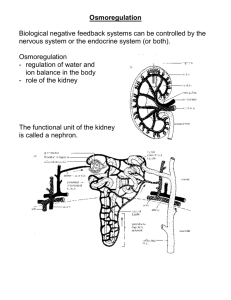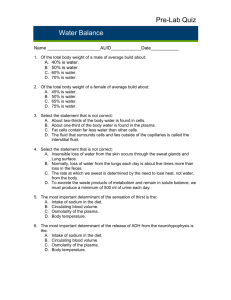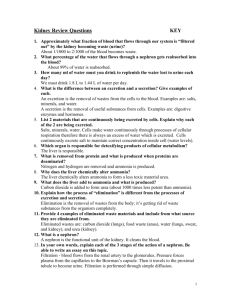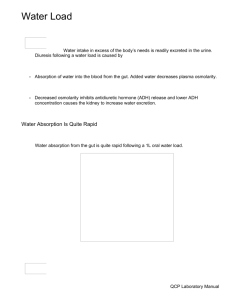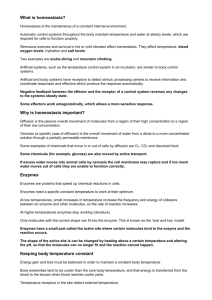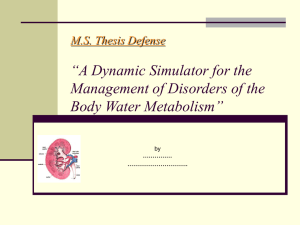093008(b).ADesai.MMathis.PhysiologyofWaterMetabolism
advertisement
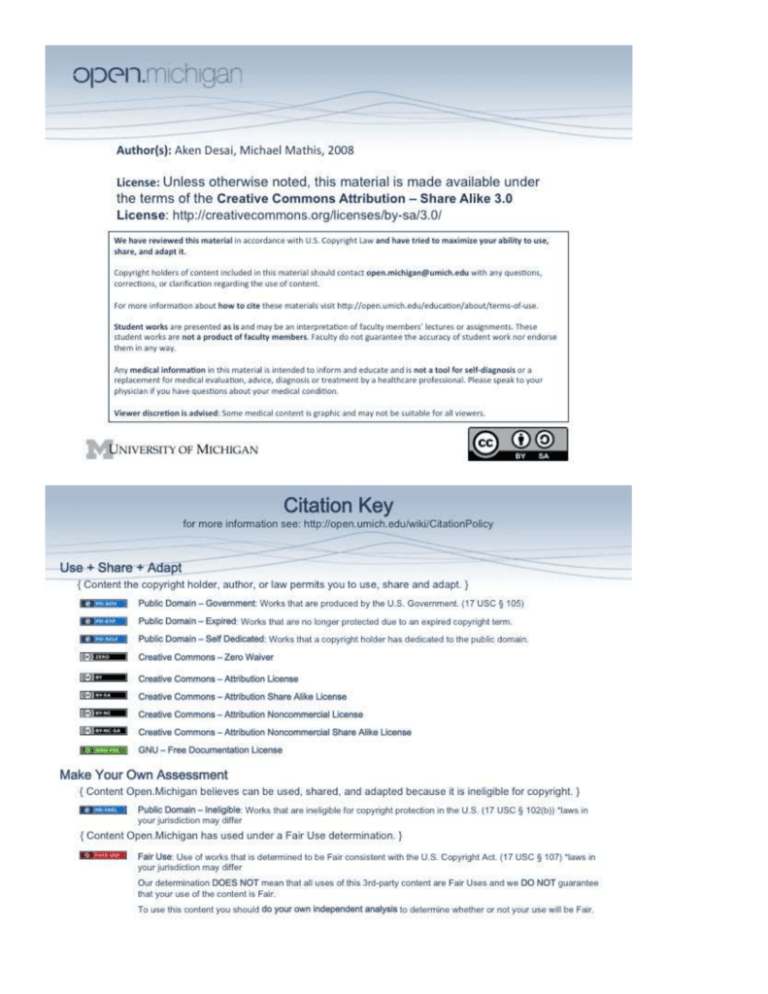
9-30-08 Physiology of Water Metabolism Volume Regulation & Osmoregulation Osmoregulation – regulation of water content via sensing osmolarity “fine tuning” of volume o Sensors – osmoreceptors in the hypothalamus o Effectors – ADH, thirst o Responses – if osmolarity too high, then concentrate urine, drink water Volume Regulation – regulation of water content by sensing “effective volume” gross adjustments o Sensors – baroreceptors in carotid sinus, atria; large vein & intrarenal receptors o Effectors – RAAS, Aldosterone, SNS, ANP, ADH o Responses – if volume too high, then excrete sodium + H2O in urine Water Balance Inputs – ingested water (1400mL), food water (850mL), oxidative phosphorylation (300mL) Outpus – urine (1500mL), skin (500mL), respiratory tract (400mL), stool (200mL) Solute Clearance & Water Balance Solute Clearance: Cosm = [Solute]urine*Volumeurine /[Solute]plasma = Uosm*V/Posm o Clearance – the amount of plasma from which a solute is removed (Volume x urine/plasma ratio!) o Units – expressed as mL/min Water Balance – can determine by comparing solute clearance to urine flow: o Solute clearance = urine flow plasma conc. = urine conc., even water balance o Solute clearance > urine flow plasma conc. < urine conc., free water retention o Solute clearance < urine flow plasma conc. > urine conc., free water excretion Renal Water Handling Proximal tubule – water flow is passive 67% of filtered sodium and H2O reabsorbed iso-osmotically Descending limb – also some passive reabsorption, H2O less permeable (closer to osmotic equilibrium?) Ascending limb – diluting segment, impermeable to water, also active Na+ transport out of limb Distal tubule (early) – diluting segment, impermeable to water Distal tubule (late) – water permeability ADH-dependent: low vol ADH water permeable, retention Collecting Duct – water permeability ADH-dependent: low vol ADH water permeable, retention Counter-current Multiplier Effect of Loop of Henle 1) Hypertonic solution created in Bowman’s space of glomerulus, but passive Na+ resorption in PCT knocks solute concentration back down to 300 mOsm by descending limb of loop of Henle 2) Active Na+ transport out of AL decreases AL osmolarity, but increases interstitium osmolarity 3) Passive diffusion of H2O out of DL attempts to balance, but really only increases DL osmolarity 4) Flow through loop high concentrations of DL reach AL, more Na+ active transport, repeat to (2) 5) Final concentrations: Pre-DL: 300, Bottom Loop: 1200, Post-AL: 100 Final Urinary Concentration ADH – the most important regulator of water balance in body Interstitial Gradient – also helps determine final urinary concentration (flux driven by conc. gradient) Maximal concentration – max. Na+ transport from AL drives conc. to 1200mOsm/L at bottom of loop, and ADHdependent water-permeable collecting duct passes by to equilibrate Minimal concentration – max. Na+ transport from AL drives conc. to 50mOsm/L at top of loop, and ADH-dependent water-impermeable collecting duct maintains this conc. ADH Regulation Osmolality – fine-tuning hypothalamic osmoreceptors react to changing plasma osmolarity, regulate ADH Volume – coarse-adjusting baroreceptors can override osmoreceptors in hypo/hypervolemia ADH ADH Names – ADH & Vasopressin o Anti-diuretic hormone – suggests renal water retention volume & pressure increase o Vasopressin – suggests vasoconstriction pressure increase ADH Measurement – most important measure of ADH effect is urine osmolality Aquaporins – ADH stimulates aquaporin channels to reach surface of collecting duct water resorption, concentrated urine o AQP 7/1 – not sensitive to ADH in thick/thin ascending limbs o AQP2 – ADH cAMP mediated signaling causes vesicles to move to apical membrane of collecting duct epithelium Thirst Mechanism – regulated by same osmo/baroreceptors, mechanism alone should be enough to prevent free water depletion, independent of ADH actions Excess water ingestion – managed by increased urine output (free water excretion) Free water depletion – managed by renal water reabsorption and water ingestion Thirst – regulated by hypothalamic receptors (subfornical organ, organum vasculosum); signaled by osmolality and hemodynamics Thirst vs. ADH – thirst mechanism not affected by presence/absence of ADH, but both driven in same way Oropharynx/Upper GI – receptors here sense a quenching of thirst, so to prevent over-correction Urine Output Oliguria – minimal urine output required to exrete daily obligate solute load (600 mosm/day) Minimal urine ouput = 600mosm/day / 1200 mosm/kg = 0.5 kg H2O/day = 500mL day Maximal urine output = 600mosm/day / 50 mosm/kg = 12kg H2O/day = 12L/day urine output; drink more than 12L water intoxication hyponatremia
